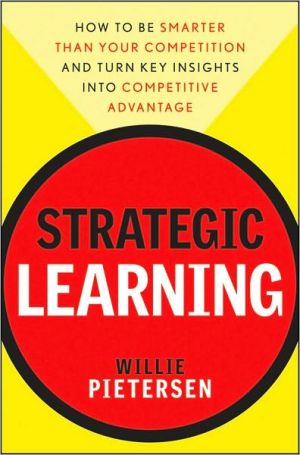Cultivating Communities of Practice: A Guide to Managing Knowledge
In Cultivating Communities of Practice, Etienne Wenger, Richard McDermott, and William M. Snyder argue that while communities form naturally, organizations need to become more proactive and systematic about developing and integrating them into their strategy. This book provides practical models and methods for stewarding these communities to reach their full potential - without squelching the inner drive that makes them so valuable.
Search in google:
In Cultivating Communities of Practice, Etienne Wenger, Richard McDermott, and William M. Snyder argue that while communities form naturally, organizations need to become more proactive and systematic about developing and integrating them into their strategy. This book provides practical models and methods for stewarding these communities to reach their full potential - without squelching the inner drive that makes them so valuable. Practical, yet grounded in rich theory, Cultivating Communities of Practice is the definitive work on how to understand organizations from a community point of view.
Chapter One \ \ \ Communities of Practice\ and Their Value to\ Organizations\ \ \ In 1988, when Japanese competition was threatening to put the Chrysler Corporation out of business, no one suspected that the resurgence of the company (now the Chrysler unit of DaimlerChrysler) would depend in part on the creation of an innovative knowledge system based on communities of practice. While some of its competitors took as little as three years to get a new vehicle to market, a typical new-product development cycle at Chrysler easily ran five years. This was no way to compete. The first order of the day was to achieve a dramatic reduction in this product-development cycle.\ The story is well known, though the role that communities of practice played is less widely understood. At the time, Chrysler was a traditional organization typical of large manufacturing operations, with functional units such as design, engineering, manufacturing, and sales. The design department would send a new design to engineering, which would send it back for redesign a few times. The design would then go to manufacturing and be returned for reengineering until the vehicle was deemed "manufacturable." The localized focus of the various functional units limited interaction between departments and thus gave rise to these unavoidable iterations. Repeated hand-offs, duplication, and therefore slowness, were built into the system.\ The decision was made to radically reorganize the unit. Engineers would now belong to "car platforms." These platforms wereproduct-oriented, cross-functional structures that focused on a type of vehicle: large cars, small cars, minivans, trucks, and Jeeps. Each platform was responsible for all phases of development associated with the whole vehicle. Engineers of all specialties reported to supervisors within the platform on which they worked. As a result, their primary focus was on the development of a specific vehicle. For instance, if you were a brakes engineer, your main allegiance, your reporting relationships, and your performance evaluation were no longer with the brakes department, but with a platform, such as small cars or minivans.\ Eventually, the move to car platforms succeeded in reducing the product-development cycle from five to two and a half years, with a corresponding cut in research and development costs. But the restructuring did not come without its own costs. A host of new problems started to appear: multiple versions of the same part with slight variations, uncoordinated relationships with suppliers, innovations that did not travel, and repeated mistakes. The company had gained the advantage of product focus, but compromised its ability to learn from its own experiences. Something had to be done to save the platform idea.\ With a clear need for communication across platforms, former colleagues from functional areas started to meet informally. Managers recognized the value of these informal meetings in fostering learning processes that cut across all platforms. Still, they wanted to keep the primary allegiance and formal reporting relationships of engineers within the platforms. Rather than formalizing these emerging knowledge-based groups into a new matrix structure, they decided to keep them somewhat informal but to sanction and support them. The Tech Clubs were born.\ Tech Clubs began to take more active responsibility for their areas of expertise. For instance, they started to conduct design reviews for their members before a design went through quality gates. In 1996, an engineering manager revived the old idea of creating an Engineering Book of Knowledge (EBoK), a database that would capture the relevant knowledge that engineers needed to do their job, including compliance standards, best practices, lessons learned, and supplier specifications. The EBoK vision could succeed only if the engineers themselves took responsibility for creating and maintaining the content. Some Tech Club leaders saw the project as an opportunity for consolidating Tech Club knowledge and taking stewardship of it. Documenting engineering knowledge had been tried several times before, but now it was part of the activities and identity of specific communities in charge of designated areas of engineering. This communal responsibility for producing the EBoK was key to its success.\ Over time, Tech Clubs progressively established their value and they have become an integral part of engineering life at the Chrysler division. Engineers have discovered that participation helps them do their jobs better, and the time spent together is a good investment. It often saves them time later and increases their confidence in their own designs. It gives them a chance to get help with specific problems, to learn what others are discovering, and to explore new technologies. Today, there are more than one hundred officially recognized Tech Clubs, plus a few emerging ones. They are responsible for a host of knowledge-based activities such as documenting lessons learned, standardizing practices for their area, initiating newcomers, providing advice to car platforms, and exploring emerging technologies with suppliers. Through the Tech Clubs, Chrysler realized the value of what today people call "communities of practice." Theirs is among the pioneering stories, but it is no longer unique. It reflects a movement spreading all over the world.\ Companies at the forefront of the knowledge economy are succeeding on the basis of communities of practice, whatever they call them. The World Bank delivers on its vision of fighting poverty with knowledge as well as money by relying on communities of practice that include employees, clients, and external partners. Shell Oil relies on communities of practice to preserve technical excellence across its multiple business units, geographical regions, and project teams. McKinsey & Company counts on its communities of practice to maintain its world-class expertise in topics important to clients who are themselves becoming smarter and more demanding. The list could go on and on. In all industries, companies are discovering that communities of practice are critical to mastering increasingly difficult knowledge challenges. They are learning to recognize and cultivate these communities. Moreover, once these communities find a legitimate place in the organization, they offer new possibilities—many yet undiscovered—for weaving the organization around knowledge, connecting people, solving problems, and creating business opportunities. And because communities of practice are not confined by institutional affiliation, their potential value extends beyond the boundaries of any single organization.\ \ \ What Is a Community of Practice?\ \ \ Communities of practice are groups of people who share a concern, a set of problems, or a passion about a topic, and who deepen their knowledge and expertise in this area by interacting on an ongoing basis. Engineers who design a certain kind of electronic circuit called phase-lock loops find it useful to compare designs regularly and to discuss the intricacies of their esoteric specialty. Soccer moms and dads take advantage of game times to share tips and insights about the subtle art of parenting. Artists congregate in cafes and studios to debate the merits of a new style or technique. Gang members learn to survive on the street and deal with an unfriendly world. Frontline managers running manufacturing operations get a chance to commiserate, to learn about upcoming technologies, and to foresee shifts in the winds of power.\ These people don't necessarily work together every day, but they meet because they find value in their interactions. As they spend time together, they typically share information, insight, and advice. They help each other solve problems. They discuss their situations, their aspirations, and their needs. They ponder common issues, explore ideas, and act as sounding boards. They may create tools, standards, generic designs, manuals, and other documents—or they may simply develop a tacit understanding that they share. However they accumulate knowledge, they become informally bound by the value that they find in learning together. This value is not merely instrumental for their work. It also accrues in the personal satisfaction of knowing colleagues who understand each other's perspectives and of belonging to an interesting group of people. Over time, they develop a unique perspective on their topic as well as a body of common knowledge, practices, and approaches. They also develop personal relationships and established ways of interacting. They may even develop a common sense of identity. They become a community of practice.\ Communities of practice are not a new idea. They were our first knowledge-based social structures, back when we lived in caves and gathered around the fire to discuss strategies for cornering prey, the shape of arrowheads, or which roots were edible. In ancient Rome, "corporations" of metalworkers, potters, masons, and other craftsmen had both a social aspect (members worshipped common deities and celebrated holidays together) and a business function (training apprentices and spreading innovations). In the Middle Ages, guilds fulfilled similar roles for artisans throughout Europe. Guilds lost their influence during the Industrial Revolution, but communities of practice have continued to proliferate to this day in every aspect of human life. Every organization and industry has its own history of practice-based communities, whether formally recognized or not. Why else are the surviving U.S. automakers all based in Detroit? What explains the high-tech fertility of Silicon Valley? And why can't you buy a world-class flute outside of three small manufacturers based in Boston?\ Communities of practice are everywhere. We all belong to a number of them—at work, at school, at home, in our hobbies. Some have a name, some don't. Some we recognize, some remain largely invisible. We are core members of some and occasional participants in others. Whatever form our participation takes, most of us are familiar with the experience of belonging to a community of practice.\ \ \ A Key to Success in a Global Knowledge Economy\ \ \ If communities of practice have been so pervasive for so long, why should organizations suddenly focus on them? It is not communities of practice themselves that are new, but the need for organizations to become more intentional and systematic about "managing" knowledge, and therefore to give these age-old structures a new, central role in the business.\ Knowledge has become the key to success. It is simply too valuable a resource to be left to chance. Companies need to understand precisely what knowledge will give them a competitive advantage. They then need to keep this knowledge on the cutting edge, deploy it, leverage it in operations, and spread it across the organization. Cultivating communities of practice in strategic areas is a practical way to manage knowledge as an asset, just as systematically as companies manage other critical assets. Indeed, the explosion in science and technology creates a difficult paradox. At the same time that the increasing complexity of knowledge requires greater specialization and collaboration, the half-life of knowledge is getting shorter. Without communities focused on critical areas, it is difficult to keep up with the rapid pace of change.\ These changes are happening at a time when firms are restructuring many relationships internally and externally to respond to the demands of a shifting market. Internally, companies are disaggregating into smaller units focused on well-defined market opportunities, as illustrated by the DaimlerChrysler Tech Club story. Externally, they increasingly partner with other organizations in the context of their extended enterprise. Both types of relationships spread production and delivery of value over many distinct entities. Communities of practice connect people from different organizations as well as across independent business units. In the process, they knit the whole system together around core knowledge requirements.\ The knowledge economy presents an additional challenge. Knowledge markets are globalizing rapidly. What someone knows in Turkey could make or break your business in London. What a competitor's team is learning in South America could be the undoing of your project in Massachusetts. Consider the example of the Siemens sales team in Malaysia that was able to get a large telecommunication contract because of the experience and material developed by their peers in Denmark. Success in global markets depends on communities sharing knowledge across the globe.\ Besides contributing to the success of organizations in world markets, these communities have another benefit. In the globalizing knowledge economy, companies are not just competing for market share. They are also competing for talent—for people with the expertise and capabilities to generate and implement innovative ideas. One company found that employees belonging to world-class communities of practice exploring cutting-edge issues were much more likely to stick around. Finding and keeping the right people can make a big difference in a company's ability to become a market leader and to gain access to venture capital. In some industries, recruiting, developing, and retaining talent is a greater challenge than competing in commercial markets.\ All these trends of the knowledge economy point to the critical role that communities of practice are destined to play. Indeed, knowledge-driven markets make it imperative to develop a "knowledge strategy" along with a business strategy. Yet many organizations have no explicit, consolidated knowledge strategy. Rather, it exists implicitly at best, dispersed in strategic plans, human resource reports, or system-improvement proposals. A knowledge strategy details in operational terms how to develop and apply the capabilities required to execute the business strategy. Therefore, a knowledge strategy eventually depends on communities of practice. Amoco and the U.S. Navy, for example, each established a process for developing such a knowledge strategy. The process starts with strategic goals and required core competencies, business processes, and key activities. It analyzes these in terms of critical knowledge "domains." Finally, it identifies the people who need this knowledge for their work and explores how to connect them into communities of practice so that together they can "steward" this knowledge.\ \ \ The Nature of Knowledge: A Managerial Challenge\ \ \ Although executives recognize the value of knowledge and the need to develop an intentional knowledge strategy, exactly how to do that is less clear. Recently, new information technologies have inspired dreams of capturing all the knowledge of an organization into databases that would make it easily accessible to all employees. Early attempts at knowledge management, however, were beholden to their origin in information technology (IT) departments. They tended to confuse knowledge and information. Building the system alone devoured resources, but it turned out to be even more difficult to motivate people to use these early knowledge bases. Companies that had invested their entire knowledge strategies in such information systems sooner or later found out that they had created digital junkyards. For instance, one consulting firm audited its knowledge systems and found it had 1,100 databases. Only thirty of them were active, and of these, at least twenty were actually news feeds. Companies discovered the hard way that useful knowledge is not a "thing" that can be managed like other assets, as a self-contained entity. Nor does it just float free in cyberspace. If companies are going to compete on knowledge, and manage and design structures and technology for it, they need to base their strategy on an understanding of what the knowledge challenge is. The essence of this challenge comes down to a few key points about the nature of knowing.\ \ \ Knowledge Lives in the Human Act of Knowing\ \ \ If a friend told you that he had read many books about surgery and was ready to operate on your skull, you would be right to decline politely. When surgeons operate on a patient, they do not blindly apply knowledge they have gleaned from books or procedures they have stored in their heads. They consider the patient's medical history, monitor vital signs, look at tissues, make incisions, draw conclusions, and possibly revise the plan to make sure that the procedure is constantly responsive to the evolving situation. Engaging their expertise in this way is an active, inventive process that is just as critical as their store of knowledge itself.\ (Continues...)\ \ \ Excerpted from Cultivating Communities of Practice by Etienne Wenger - Richard McDermott - William M. Snyder. Copyright © 2002 by Etienne Wenger, Richard McDermott, and William M. Snyder. Excerpted by permission. All rights reserved. No part of this excerpt may be reproduced or reprinted without permission in writing from the publisher. \ \ \ \
Preface1Communities of Practice and Their Value to Organizations12Communities of Practice and Their Structural Elements233Seven Principles for Cultivating Communities of Practice494The Early Stages of Development: Planning and Launching Communities of Practice655The Mature Stages of Development: Growing and Sustaining Communities of Practice936The Challenge of Distributed Communities1137The Downside of Communities of Practice1398Measuring and Managing Value Creation1619Community-Based Knowledge Initiatives18710Reweaving the World: Communities beyond Organizations219Notes233Bibliography261Index275About the Authors283
\ Practical, yet grounded in rich theory, Cultivating Communities of Practice is the definitive work on how to understand organizations from a community point of view.\ \ \ \ \ Publishers WeeklyAmong the myriad challenges managers in large corporations face today, one is becoming increasingly important: how to make the best use of the knowledge that a company's employees possess. The authors consultants all lift models from Xerox, DaimlerChrysler and the World Bank to show how to tap into the wisdom within, making this book helpful, in theory. Wenger, McDermott and Snyder spend much time explaining ways to organize, maintain and sustain communities of practice, which they define as groups that "share a concern, a set of problems, or a passion about a topic, and... deepen their knowledge and expertise in this area by interacting on an ongoing basis." Laying out a logical, step-by-step process for building one of these communities, the authors define specific roles for each member of the group. But senior managers looking, as the subtitle suggests, for "a guide to managing knowledge" may be disappointed in the scant space actually devoted to developing a system that captures and manages the learning that comes out of a "community of practice." Managers seeking the best way to obtain and use the knowledge coming out of these groups probably won't find it here. (Mar. 6) Forecast: Wenger is the biggest name in the theory of communities of practice, and those familiar with his work will want to add this book to their collection. Neophytes would do better with his 1998 primer, Communities of Practice. Copyright 2001 Cahners Business Information.\ \ \ Soundview Executive Book SummariesA New Look at Old Ways of Managing Knowledge\ What are "communities of practice"? The authors, each a seasoned organizational consultant and an expert on the subject, write that they are "groups of people who share a concern, a set of problems, or a passion about a topic, and who deepen their knowledge and expertise in this area by interacting on an ongoing basis." \ These informal groups can range from engineers who use a particular technology or tool and get together to discuss the fine points of their common focus, to groups of soccer moms and dads sharing parenting tips during a game. They are made up of people who do not necessarily work together every day, but they find their meetings informative and valuable. When the members of these communities are together, they share information, tips and insights, help each other solve problems, and discuss their common needs and concerns.\ Communities of practice have a long history, and are a fundamental way for people to share their unique perspectives on their topics and bodies of common knowledge. During the Middle Ages, guilds served the same function for the artisans of Europe, and now they are everywhere and represent both visible groups and informal gatherings that occur when several like-minded individuals discuss their common concerns.\ They are made up of core members as well as occasional participants, and the authors write that they should serve a central role in businesses. They also write that managers must face the challenge of helping them become intentional and systematic ways for organizations to manage knowledge.\ Keeping Up With Changes\ According to the authors, the key to successin a global knowledge economy is learning how to keep knowledge on the cutting edge, how to deploy it, and how to leverage it in operations and spread it throughout the organization. Considering how knowledge is becoming more complex every day, and the global nature of expanding knowledge markets, they write that organizations need communities of practice that are focused on critical areas to keep up with changes.\ Communities of practice can contribute greatly to competitive advantage, global success and even the recruitment of new talent, because they recognize that knowledge is both social and individual. Appreciating the collective nature of knowledge is the job of management, and "conventional structures do not address knowledge-related problems as effectively as they do problems of performance and accountability." The authors write that communities of practice are the ideal social structure for "stewarding" knowledge, and managers can facilitate their effectiveness by assigning responsibility to the people who generate and share the knowledge they need, and cultivating these social forums that support the "living nature of knowledge."\ Many Forms of Community\ The authors write that communities of practice can consist of only a few specialists, or can consist of hundreds of people, but the larger ones might require subdivision by region or subtopic to encourage member participation. Some can exist for just a few years, and others, such as those that pass skills from generation to generation, have existed for centuries.\ They can be spread over vast distances and communicate via e-mail, or they can be local and meet face-to-face regularly. They can be made up of people from the same discipline, or they can combine people with different backgrounds. Although their purposes can vary, they all share a basic structure that combines these three elements:\ \ A domain of knowledge: This creates common ground and a sense of common identity. A well-defined domain affirms a community's purpose and value to stakeholders.\ A community: This creates the social fabric of learning. Strong communities foster interaction and relationships that are based on mutual respect and trust.\ A practice: This is a set of frameworks, ideas, tools, information, styles and documents that community members share.\ \ \ \ \ Why Soundview Likes This Book\ The authors have created a practical guide for managers to help them understand, implement and cultivate this tool for increasing the productivity of knowledge workers. By explaining the conceptual foundations of communities of practice along with the art of developing them, they provide firm grounds on which managers can build them within their own organizations. Not only do they clearly present a solid case for moving the concept from theory to practice, but they also present ways for organizations to measure and manage communities of practice while maximizing their potential, within business, government, education and the wider community at large. Copyright (c) 2002 Soundview Executive Book Summaries\ \ \ \ \ \ Soundview Executive Book SummariesA New Look at Old Ways Of Managing Knowledge\ What are "communities of practice"? The authors, each a seasoned organizational consultant and an expert on the subject, write that they are "groups of people who share a concern, a set of problems, or a passion about a topic, and who deepen their knowledge and expertise in this area by interacting on an ongoing basis."\ These informal groups can range from engineers who use a particular technology or tool and get together to discuss the fine points of their common focus, to groups of soccer moms and dads sharing parenting tips during a game. They are made up of people who do not necessarily work together every day, but they find their meetings informative and valuable. When the members of these communities are together, they share information, tips and insights, help each other solve problems, and discuss their common needs and concerns.\ Communities of practice have a long history, and are a fundamental way for people to share their unique perspectives on their topics and bodies of common knowledge. During the Middle Ages, guilds served the same function for the artisans of Europe, and now they are everywhere and represent both visible groups and informal gatherings that occur when several like-minded individuals discuss their common concerns.\ They are made up of core members as well as occasional participants, and the authors write that they should serve a central role in businesses. They also write that managers must face the challenge of helping them become intentional and systematic ways for organizations to manage knowledge.\ Keeping Up With Changes\ According to the authors, the key to success in a global knowledge economy is learning how to keep knowledge on the cutting edge, how to deploy it, and how to leverage it in operations and spread it throughout the organization. Considering how knowledge is becoming more complex every day, and the global nature of expanding knowledge markets, they write that organizations need communities of practice that are focused on critical areas to keep up with changes.\ Communities of practice can contribute greatly to competitive advantage, global success and even the recruitment of new talent, because they recognize that knowledge is both social and individual. Appreciating the collective nature of knowledge is the job of management, and "conventional structures do not address knowledge-related problems as effectively as they do problems of performance and accountability." The authors write that communities of practice are the ideal social structure for "stewarding" knowledge, and managers can facilitate their effectiveness by assigning responsibility to the people who generate and share the knowledge they need, and cultivating these social forums that support the "living nature of knowledge."\ Many Forms of Community\ The authors write that communities of practice can consist of only a few specialists, or can consist of hundreds of people, but the larger ones might require subdivision by region or subtopic to encourage member participation. Some can exist for just a few years, and others, such as those that pass skills from generation to generation, have existed for centuries.\ They can be spread over vast distances and communicate via e-mail, or they can be local and meet face-to-face regularly. They can be made up of people from the same discipline, or they can combine people with different backgrounds. Although their purposes can vary, they all share a basic structure that combines these three elements:\ \ A domain of knowledge: This creates common ground and a sense of common identity. A well-defined domain affirms a community's purpose and value to stakeholders.\ A community: This creates the social fabric of learning. Strong communities foster interaction and relationships that are based on mutual respect and trust.\ A practice: This is a set of frameworks, ideas, tools, information, styles and documents that community members share.\ \ Why We Like This Book The authors have created a practical guide for managers to help them understand, implement and cultivate this tool for increasing the productivity of knowledge workers. By explaining the conceptual foundations of communities of practice along with the art of developing them, they provide firm grounds on which managers can build them within their own organizations. Not only do they clearly present a solid case for moving the concept from theory to practice, but they also present ways for organizations to measure and manage communities of practice while maximizing their potential, within business, government, education and the wider community at large.\ \







